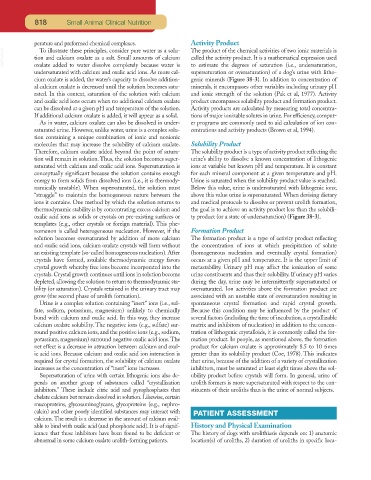Page 788 - Small Animal Clinical Nutrition 5th Edition
P. 788
818 Small Animal Clinical Nutrition
perature and preformed chemical complexes. Activity Product
To illustrate these principles, consider pure water as a solu-
VetBooks.ir tion and calcium oxalate as a salt. Small amounts of calcium The product of the chemical activities of two ionic materials is
called the activity product. It is a mathematical expression used
to estimate the degrees of saturation (i.e., undersaturation,
oxalate added to water dissolve completely because water is
undersaturated with calcium and oxalic acid ions. As more cal- supersaturation or oversaturation) of a dog’s urine with litho-
cium oxalate is added, the water’s capacity to dissolve addition- genic minerals (Figure 38-3). In addition to concentration of
al calcium oxalate is decreased until the solution becomes satu- minerals, it encompasses other variables including urinary pH
rated. In this context, saturation of the solution with calcium and ionic strength of the solution (Pak et al, 1977). Activity
and oxalic acid ions occurs when no additional calcium oxalate product encompasses solubility product and formation product.
can be dissolved at a given pH and temperature of the solution. Activity products are calculated by measuring total concentra-
If additional calcium oxalate is added, it will appear as a solid. tions of major ionizable solutes in urine. For efficiency, comput-
As in water, calcium oxalate can also be dissolved in under- er programs are commonly used to aid calculation of ion con-
saturated urine. However, unlike water, urine is a complex solu- centrations and activity products (Brown et al, 1994).
tion containing a unique combination of ionic and nonionic
molecules that may increase the solubility of calcium oxalate. Solubility Product
Therefore, calcium oxalate added beyond the point of satura- The solubility product is a type of activity product reflecting the
tion will remain in solution.Thus, the solution becomes super- urine’s ability to dissolve a known concentration of lithogenic
saturated with calcium and oxalic acid ions. Supersaturation is ions at variable but known pH and temperature. It is constant
conceptually significant because the solution contains enough for each mineral component at a given temperature and pH.
energy to form solids from dissolved ions (i.e., it is thermody- Urine is saturated when the solubility product value is reached.
namically unstable). When supersaturated, the solution must Below this value, urine is undersaturated with lithogenic ions;
“struggle” to maintain the homogeneous nature between the above this value urine is supersaturated. When devising dietary
ions it contains. One method by which the solution returns to and medical protocols to dissolve or prevent urolith formation,
thermodynamic stability is by concentrating excess calcium and the goal is to achieve an activity product less than the solubili-
oxalic acid ions as solids or crystals on pre-existing surfaces or ty product (or a state of undersaturation) (Figure 38-3).
templates (e.g., other crystals or foreign material). This phe-
nomenon is called heterogeneous nucleation. However, if the Formation Product
solution becomes oversaturated by addition of more calcium The formation product is a type of activity product reflecting
and oxalic acid ions, calcium oxalate crystals will form without the concentration of ions at which precipitation of solute
an existing template (so-called homogeneous nucleation). After (homogeneous nucleation and eventually crystal formation)
crystals have formed, available thermodynamic energy favors occurs at a given pH and temperature. It is the upper limit of
crystal growth whereby free ions become incorporated into the metastability. Urinary pH may affect the ionization of some
crystals. Crystal growth continues until ions in solution become urine constituents and thus their solubility. If urinary pH varies
depleted, allowing the solution to return to thermodynamic sta- during the day, urine may be intermittently supersaturated or
bility (or saturation). Crystals retained in the urinary tract may oversaturated. Ion activities above the formation product are
grow (the second phase of urolith formation). associated with an unstable state of oversaturation resulting in
Urine is a complex solution containing “inert” ions (i.e., sul- spontaneous crystal formation and rapid crystal growth.
fate, sodium, potassium, magnesium) unlikely to chemically Because this condition may be influenced by the product of
bond with calcium and oxalic acid. In this way, they increase several factors (including the time of incubation, a crystallizable
calcium oxalate solubility. The negative ions (e.g., sulfate) sur- matrix and inhibitors of nucleation) in addition to the concen-
round positive calcium ions, and the positive ions (e.g., sodium, tration of lithogenic crystalloids, it is commonly called the for-
potassium, magnesium) surround negative oxalic acid ions.The mation product. In people, as mentioned above, the formation
net effect is a decrease in attraction between calcium and oxal- product for calcium oxalate is approximately 8.5 to 10 times
ic acid ions. Because calcium and oxalic acid ion interaction is greater than its solubility product (Coe, 1978). This indicates
required for crystal formation, the solubility of calcium oxalate that urine, because of the addition of a variety of crystallization
increases as the concentration of “inert” ions increases. inhibitors, must be saturated at least eight times above the sol-
Supersaturation of urine with certain lithogenic ions also de- ubility product before crystals will form. In general, urine of
pends on another group of substances called “crystallization urolith formers is more supersaturated with respect to the con-
inhibitors.” These include citric acid and pyrophosphates that stituents of their uroliths than is the urine of normal subjects.
chelate calcium but remain dissolved in solution.Likewise,certain
mucoproteins, glycosaminoglycans, glycoproteins (e.g., nephro-
calcin) and other poorly identified substances may interact with PATIENT ASSESSMENT
calcium. The result is a decrease in the amount of calcium avail-
able to bind with oxalic acid (and phosphoric acid). It is of signif- History and Physical Examination
icance that these inhibitors have been found to be deficient or The history of dogs with urolithiasis depends on: 1) anatomic
abnormal in some calcium oxalate urolith-forming patients. location(s) of uroliths, 2) duration of uroliths in specific loca-

